M. Isidora Forrest's Blog, page 15
March 26, 2023
Isis and the Word
 An Isis healing statue
An Isis healing statueThis beautiful statue of Isis is Late Period dynastic, about 664-525 BC. It is made of greywacke, a very hard, dark-grey sandstone, and sits slightly over two feet high. That’s about the size of my own (not, however, made of greywacke) image of the Goddess. This one is more detailed than mine, particularly in the hieroglyphs that cover Her throne.
And those hieroglyphs are important. Very important. Because, you see, they are words. And words, written and spoken, were sacred to the ancient Egyptians and are sacred to Our Lady Isis.

We often take words for granted as we communicate in work emails, casually speak with our friends, or yell at the cat to get off the table. But we shouldn’t. Words have power. Words have magic. Remember the first time someone said to you, “I love you.” Did you not feel the power of those words? Did hearing them not cause a flow of energy through your body, a thrill in the bottom of your belly, a flood of emotion in your heart?
On the flip side of the coin, we adults often struggle against negative words spoken to us as children: you’re a loser, you’re ugly, I hate you. Those words, too, have a visceral effect.
 Isis protects Osiris with Her wings
Isis protects Osiris with Her wingsThis beautiful work, with its hieroglyphs carved upon the throne of the Goddess Throne, has been identified as a healing statue of Isis. The words thickly covering Her throne are a healing formula. The ancient Egyptians would have used this image by pouring pure Nile water over the statue so that the magic of the words infused the water. Then the patient would have drunk the healing water.
To the ancient Egyptians, what we think of as “just” words—really “just” representations of words—were meant to have real effect in the real world. In fact, the power of words is vital to Egyptian magic; so much so that we can think of it as a defining characteristic.
From the very beginning, Isis is associated with words. She is the Lady of Words of Power. She is the Great Enchantress; She works Her magic by means of words—She chants and we are enchanted. As Isis is in command of Words of Power, She is called Great of Magic and She is the Goddess of Magic. A spell from the Graeco-Egyptian magical papyri claims to be effective because it is done “according to the voice of Isis, the magician, the lady of magic, who bewitches everything, who is never bewitched in Her name of Isis, the magician.” When you are dead, one thing you really want to happen is for Isis to speak your name—your own special word that can encapsulate your very essence.
Hail to you is what Isis, Lady of the Deserts says. Be preeminent within the Sacred Booth [that is, the embalming chamber] for She speaks your good name within the Barque [of Re] on the day of reckoning characters. [The “day of reckoning characters” refers to the Judgement before Osiris.]
Coffin Texts, Spell 48
Interestingly, Isis is one of the ancient Egyptian Deities for Whom we have a great deal of attributed speech. Some scholars think that may be because of the famous lamentations of Isis and Nephthys for Osiris. The lamentations are extensive; there’s a lot of speaking in them. And while both Sisters lament the God, at least in the lamentations we have copies of, it is Isis Who does the most speaking.
 Speaking magic
Speaking magicWhat’s more, since Osiris is dead, He cannot speak for Himself. It is Isis Who speaks for Him, and Her words not only comfort Him, but they are also what protects Him in His vulnerable state. Isis commands and others act. She orders the Sons of Horus to protect Their father. We hear many times of the words of Isis driving off “the rebels,” that is, the enemies of Osiris, “by the spells of Her mouth.” Through Her speech, Isis removes physical dangers, and also negates the “spells of the enchanters” who work evil magic. She is the one who has “Life in Her mouth.” When She speaks, the venom of poisonous creatures drains out of the sufferer and “falls down upon the ground,” incapable of causing further harm.
We often learn of Isis’ powers from the Goddess Herself. On the Metternich Stele, Isis declares
I am Isis, possessor of magic, who performs magic, effective of speech, excellent of words.
Metternich Stele
These “I am Isis” statements, which I believe facilitated the development of the famous Isis aretalogies, make me wonder whether the Goddess was, in effect, working magic on Herself. Was She making Herself more powerful through magical words addressed to Herself? And, if so, are there not magical lessons we can learn from Her? Indeed, rituals in Isis Magic often start with the ritualist making an affirmative statement of their own position and power, e.g. “I am a priestess of Isis, I am a child of the Goddess.”

Of course, not everyone feels comfortable speaking in ritual. Yet, if we are to follow our Goddess’ example, it is an ability worth developing. We are not all Shakespearean dramatists, yet we can still bring our own kind of power to the spoken words and prayers we use in ritual. We can try whispering. Or speaking slowly, being aware of the meaning of each word as we say it. We feel how it forms on our tongue and in our mouth. We are aware of the air and the effort required to speak each word. For more urgent invocations, we might try speak quickly or loudly. We might try speaking a little ancient Egyptian, to the extent that we can know it. “Amma, Iset;” “grant that it be so, Isis” can serve as an Egyptian “so mote it be.” “Iu en-i (Eeoouu-en-ee). Iu en-i, Iset” means “come to me, come to me, Isis” and is a simple calling. Or try speaking
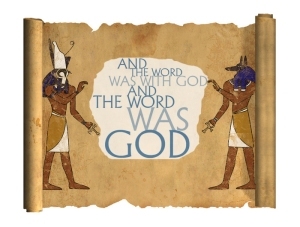
The ancient Egyptians knew that the sounds produced during the speaking of words as well as the letters used to write them held magic. A Hermetic text from the early centuries of the Common Era expressed the Egyptian tradition that the quality of the speech and the very sound of the Egyptian words contain the energy of the objects of which they speak and are “sounds full of action.” This is precisely why magic words are powerful: they contain the energy of the objects they name, and this energy is the energy of original Creation, when all things were as they were intended to be. By accessing this primordial power, we may use it to bring about desired changes—such as healing in the case of the magical statue we’ve been discussing.
At Busiris in the Egyptian delta, Isis was even called Djedet Weret, the Great Word. This concept may be familiar to many of us from the idea of Jesus Christ as the Logos—the Word (of God)—in Christian myth. Thus this idea is neither unique nor original to Christianity.
I believe this is because, at least on a gut level, we human beings have always, always understood the power of The Word. We can look to the ancient Egyptians as one of the earliest models of a society with great reverence for the Sacred Word and to Isis as an early model of a Deity Who personifies the Great Word.
March 19, 2023
Isis, Osiris & the Rites of Spring

I’m up to my magical ears in Spring Equinox events this weekend, so here’s a spring-y repost.
While some of us are under a crazy last-gasp-of-winter storm, lucky ones (like me) are enjoying a first-breath-of-spring day.
The coming of the light, the green uprisings from the dark earth, the deep, needed breath. These things open us, make our spirits expand, and give us hope.
Do you feel it? Even now? Even today, as difficult as things are? I hope you do. I wish for you that you do, just as we human beings always have…
The ancient Egyptians certainly knew that feeling and celebrated it. In his essay “On Isis and Osiris,” the Greek priest Plutarch mentions an Egyptian festival that he says marked the beginning of spring and was called ‘The Entry of Osiris Into the Moon.’ Here’s what he says about it:
Further, on the first day of the month of Phamenoth they hold a festival, which they call ‘The Entry of Osiris into the Moon,’ for it is the beginning of spring. Thus they locate the power of Osiris in the moon and say that Isis, as the creative principle, has intercourse with him. For this reason they also call the moon the mother of the world and they believe her nature to be both male and female since she is filled and made pregnant by the sun while she herself in turn projects and disseminates procreative elements in the air.
Plutarch, “On Isis and Osiris,” 43
In his discussion of this passage, Egyptologist J. Gwyn Griffiths notes that there is no festival by that name in any known Egyptian calendar.
 Isis and Nephthys in a boat with Osiris. I believe this is the image to which Griffiths refers.
Isis and Nephthys in a boat with Osiris. I believe this is the image to which Griffiths refers.The closest thing is a temple carving from Denderah that shows Osiris in a boat with Isis and Nephthys and explains that Osiris is “entering into the Left Eye.” The Left Eye, as you may know, is usually an Egyptian designation for the moon. In the Denderah text, spring is not mentioned, but Osiris is said to do His entering on the 15th of the month, that is, at the full moon.
Plutarch is seeing things in a Greek way, with Isis as a lunar Goddess and Osiris in a solar aspect. But for the Egyptians, the moon was associated with Gods—Thoth, Iah, Khonsu—not Goddesses. And though Osiris is united daily with the Sun God Re in the Underworld, He too is more associated with the moon than the sun.
Nevertheless, in this case, it seems we should be envisioning a solar Osiris as He enters into and unites with the moon—thus establishing His power there—in order to create the brilliant light of the full moon (if we can include the Denderah text in our understanding).
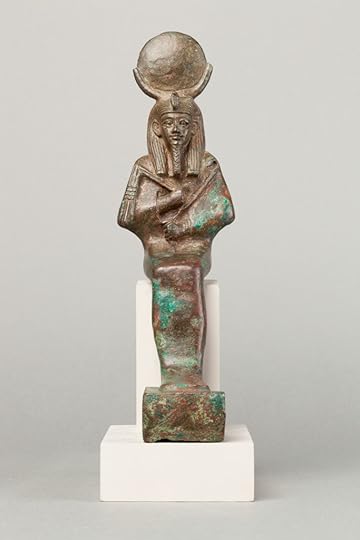 Osiris-Iah, Osiris the Moon
Osiris-Iah, Osiris the MoonYet there is a slight problem. Plutarch says that this festival happens on the “noumenia tou Phamenoth,” the new moon of the spring month of Phamenoth. And indeed, the Egyptian lunar calendar, the temple calendar, starts with the new moon. This would mean the minuscule bits of evidence we have for this festival of Osiris entering into the moon are in conflict. Does the God enter at the new moon or full?
If we just look at what Plutarch says, then Osiris enters into the new moon and Isis, the Creative Principle, unites with Him in sexual intercourse. She becomes the Mother of the World; Isis the moon is filled and made pregnant by the Osirian sun. During this time, the moon is both male and female since Isis and Osiris are united in it. But pregnancy is a process of growth. Could both of our tiny bits of information be right? What if the festival was not meant as a one-day event? What if the 14 days from new moon to full were envisioned as a sort of spring break retreat for the Goddess and God? They come together, make love, and 14 days later the full, round, and shining evidence of the Goddess’ pregnancy can be clearly seen. It’s just speculation, but it does provide some coherence between the few pieces of evidence we have for this festival.
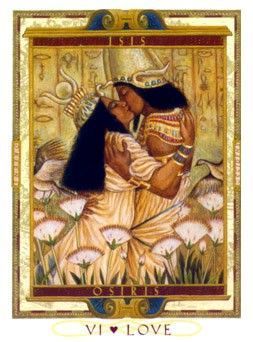 Isis & Osiris as lovers from Kris Waldherr’s Lovers Path Tarot
Isis & Osiris as lovers from Kris Waldherr’s Lovers Path TarotWhatever the case, I very much like the idea of a spring sexual rite for Isis and Osiris. In fact, it was this intriguing Plutarchian reference that inspired the multi-day rite of sacred sexuality in Isis Magic called (yes, of course) ‘The Entry of Osiris Into the Moon.’
Plutarch’s essay is also responsible for the idea that Isis and Osiris were so in love with each other that They made love while still within Their mother Nuet’s womb. He writes, “Isis and Osiris were enamored of each other and consorted together in the darkness of the womb before Their birth.” Perhaps Their coming together at the first of spring each year may be seen as a kind of return to the womb of the Great Mother for renewal of both Deities as well as humankind…the very same renewal we all feel every spring.
What’s more, as famous lovers, Isis and Osiris are also to be found in the Greco-Egyptian Magical Papyri (Papyri Graecae Magicae, abbreviated PGM) in a variety of old-fashioned love spells. While many of the so-called “love” spells in the papyri are coercive and more like magical roofies than what I would call “love” magic, there is one I particularly like because it seems the lover does want love and not just sex from the object of his desire.
 Union of the Moon and Sun
Union of the Moon and SunIn a spoken part of the spell, the lover says, “The Goddess in heaven looked down upon him, and it happened to him according to every wish of his soul. [Name of the lover] says: From the day [and] from the hour, I [name of the lover] do this act to you; you will love me, be fond of me, and value me . . . [until] I die. O Lady, Goddess Isis, carry out for me this perfect charm.” The rite takes place before sunrise, as the lover anoints himself with myrrh, “the myrrh with which Isis anointed when She went to the bosom of Osiris.” As the sun rises, the lover asks Isis to wake up his beloved and again to “carry out this perfect charm.”
If you’re feeling in need of a love spell yourself, here’s one to try.
And so, with loving thoughts, I wish you blessings of the coming season of wild uprisings, renewed love, and new life in whatever best form it takes for you. We all need it and we all deserve it.
March 12, 2023
Worshiping Isis
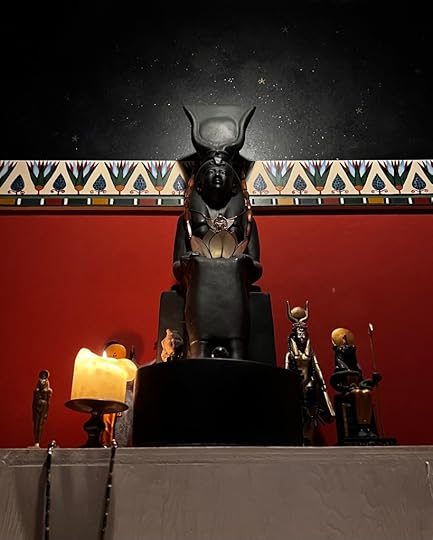
It is morning and quiet here.
I enter Her shrine, light the candles, ignite the charcoal in the censer, pour Nile Water into the cup. The stillness of the morning settles in the shrine and in me. I sit on the floor before Her sacred image, looking up at Her.
“Hello, Isis,” I think to Her. No response. But I do not really expect one. Not yet.
I breathe, slowly, deeply. I focus on my own consciousness, which I sense centered in my head. Then, on a breathe, I let my consciousness roll out and out and out, expanding into the unseen world, where She Is, where I can greet Her.
“I am open unto Isis, only Isis,” I whisper into the stillness. I breathe, opening my mind and body and Self to Her.
 The water vessel filled with Nile Water
The water vessel filled with Nile WaterI take up the cup with Nile Water, elevate it. I call out to the Souls—the Bau—of Night asking Them to embue this water with Their purifying powers in Her name. I envision blue light flowing into the cup. I sense starlight. I feel a slight heaviness in the cup.
I sprinkle water throughout the shrine. East, south, west, north. I sprinkle myself with this ensouled water. I speak the purifying formula, adapted from ancient texts. “Isis is pure, I am pure…” As I breathe in, blue light spirals into my core. As I breathe out, it reverses direction, carrying impurities out with it. I do this until I feel balanced and ready to come before Her in worship.
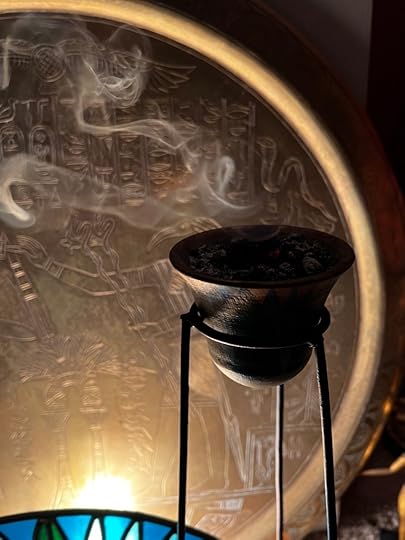 A hand-painted censer with lotus flowers
A hand-painted censer with lotus flowersI take up the censer, place incense on the coal. Scented smoke rises. I call out to the Bau of Day asking Them, in Her name, to fill the censer with Their consecrating powers. Red light settles around the censer; its heat increases. I waft the smoke throughout the shrine as before. “Isis is consecrated, I am consecrated…” I coax the scent over my body. I breathe in the red consecration until I am replete, consecrated to Her worship.
I sit. Breathe. Open my consciousness again. I sense Her waiting on the edges of that consciousness.
I raise my hands, beckoning. I speak the very simplest of all the Egyptian invocations I know. “Iu en-i (Eeoouu-en-ee). Iu en-i, Iset,” I say. “Come to me, come to me, Isis.” I repeat this, softly, letting my words, my desire flow out to Her.
And suddenly the shrine is full of wings. Now it feels a bit crowded in here, but I let my ka relax, that it may better touch Hers. She shows Her beautiful face to me. Large, dark, almond eyes. Wide mouth. Long, wide nose. The shrine is full of wings and feathers, impossibly multi-hued. And it is full of Her.
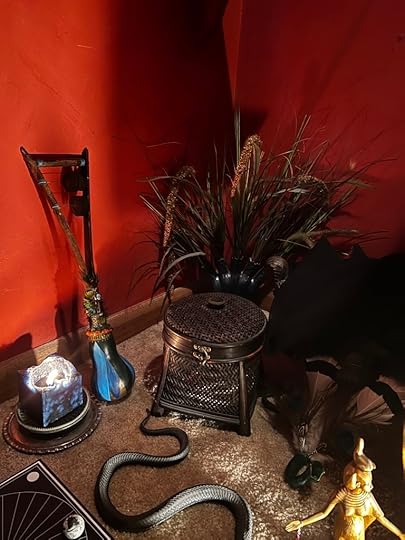 She has serpents and sistra
She has serpents and sistraI have come to worship, so I ask what She desires. “Your thoughts and offerings help Us abide in Our images [She means the sacred images we obtain and consecrate for Her and for all our Divines Ones] and in your hearts,” She says. “Spend time, make offering.”
She is before/around me now. She begins to breathe through my being. She is concentrating on the shenu—the energy centers—of my third eye and my heart. [I think this means either those centers are the most sensitive in me right now, or perhaps the least sensitive and they need work. I am not sure.] She breathes out, I breathe Her into my centers. Hold. I breathe out, She breathes into Her shenu and holds the power. We do this again and again. “What do you feel?” She asks. “Expansion. Excitement. Connection to You,” I say. “Worshiping is communion,” She says. “Your thoughts of Me are the flowers I choose for My garden.”
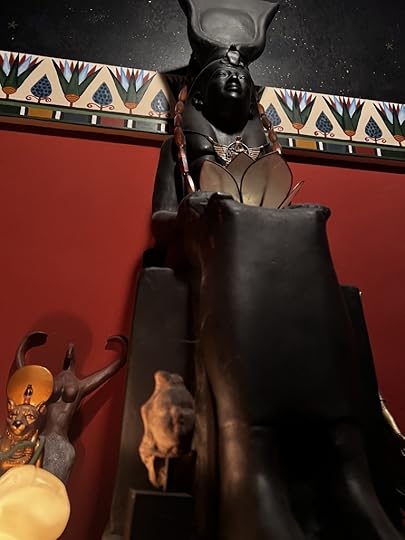 She, with Harpokrates, Werethekau, and the Goddess with Upraised Arms
She, with Harpokrates, Werethekau, and the Goddess with Upraised ArmsI think blue lotuses for Her.
She takes them.
“Look into My eyes,” She says, “into the Black of the Kore.” [She is referring to this.] I do. “Worship begins at the Origin and ends there, too,” She says. “Worship is exchange, energy, offering, love. Worship is being in harmony with. Worship is rising in the Boat of the Morning and setting in the Boat of the Night. Worship is surrender that I may uplift you. Worship is vulnerability before Me, a release of fear. Worship is just love; you for Me, Me for you,” She says.
I sit then, in worship, as I do whenever I enter Her shrine, and whenever I think of Her. I am content. She, I think, is also content.
And that is how it went this time.
March 5, 2023
The Is-ness of Isis
 An Isis altar at The Hallows
An Isis altar at The HallowsI don’t often rant on this blog, as those of you who have been following along well know. But you are about to read one. Sorry. But it’s a tiny one. And kindly meant.
You see, every now and then, this little rant gets kicked off by me reading the work of other writers. I don’t mean scholars. I mean people who have a genuine, living relationship with their Deities. And yet, they often do not use the present tense when speaking or writing about their Deities. Now you see where this is going.
Perhaps you’ve noticed that, in my books and on this blog—except when something actually is in the past—I refer to the Goddess in present tense. In fact, I have been very conscious of doing so. (And it goes without saying that I am imperfect in this endeavor.)
Why so important? Because, you see, She IS.
 I am all that was, that is, that ever shall be…
I am all that was, that is, that ever shall be…She’s is not a Being Who was but is no more. She is not “just a myth,” an old story deserving of the past tense. Indeed, She is All that Is, and Was, and Ever Shall Be. She existed then, She exists now, and She will exist when the rugged, snowcapped mountain that, on a clear day, I can see from my rooftop has become a gentle, green hill.
And I know you know that. Which is why I am so puzzled when I sometimes see modern Pagans, Polytheists, Wiccans, Witches, and insert-your-self-definition-of-choice-here using the past tense about their Deities. The most recent one I saw, and which sparked this little rant, was a witch writing that “Hekate was…”
It happens most often when we’re telling Their sacred stories, trying to offer a brief “definition” of the Deity, or describing Their relationships with other Deities: “Isis was the Goddess of Magic.” Osiris was the husband of Isis.” Isn’t She still the Goddess of Magic? Isn’t He still Her husband? Now if we said, “To the ancient Egyptians, Isis was the Goddess of Magic and Osiris was Her husband,” that would work. No ancient Egyptians around today, so their formulations about their Deities are history. But to me and to others—perhaps like you?—who know Her, Isis IS the Goddess of Magic and Osiris IS Her beloved husband.
In writing of the history of the Isis religion and the many aspects in which She has appeared to humanity, I have always kept in mind that, to the people who worshiped Her then, as well as to those of us who do so today, Isis was and is a Living Goddess. She is not a historical curiosity. She is not a metaphor for our times. She is not feminist wish fulfillment. She is not merely a psychological archetype. She is Divine Love, Life, Magic, Mystery. She is Goddess and She is.
Isis Magic
And speaking of myths, a myth isn’t something that is false, though people certainly use it that way. But no. A myth is a sacred story meant to tell us something about the Deity or Deities of the myth. Myths are “things that never happened but always are,” in the words of the 4th century CE Roman writer Sallustius. Or maybe myths are things that never happened historically, but are eternally true. And while I’m ranting, just because a story belongs to the corpus of the dominant monotheisms doesn’t mean it’s not mythology. Egyptian mythology is. Christian mythology is. Jewish mythology is. They are all sacred stories and they are all mythology.
 This is from a 2014 public dance party in San Francisco, mixed by the Bulgarian artist KINK.
This is from a 2014 public dance party in San Francisco, mixed by the Bulgarian artist KINK.I think most of the problem comes from early and ongoing conditioning. Except for those of you young enough to have been born of Pagan parents, most of us were taught in school, from early on, that the ancient Deities were and mythology was. But let’s get over that, shall we? Can we all just mind our tenses and our mythic terms, please?
The Is-ness of Isis
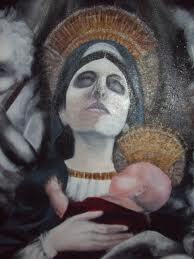 A powerful Madonna & Child
A powerful Madonna & ChildBut how do we know that Isis is? How do we know that She’s “real”? Must we simply “have faith”? Do we just choose to “believe in” Her? Can we prove Her is-ness?
We can prove Isis’ is-ness—Her reality—exactly as much as any human being can prove the reality of any Deity, which is to say, we cannot. There is no scientific proof for the Divine. There is no infallible book or teacher that holds all the answers to all the questions, though many will so claim. Yet happily, this means exactly nothing when it comes to the truth of Isis’ existence.
This question of belief and faith is much more vexed for those of us in non-mainstream (O how I dislike that designation!) religions. How often have you been asked by some friend or family member or hopefully-well-meaning stranger, “Well, then, what do Isians—or Pagans or Polytheists or Wiccans or Witches or insert-your-self-definition-of-choice-here—believe?”
And how have you answered?
Many of us involved in alternative spirituality today (at least in the west) were reared in one monotheistic religion or another, most often, Christianity. From early on, we were taught to “believe in” God and Jesus. We were told that a particular book is the Word of God, “proves” that God is real, and explains precisely what He wants us to do with our lives. In terms of religion, the clergy are to be our role models—they whose faith is strong, whose belief is true; we should have faith and believe as they do.
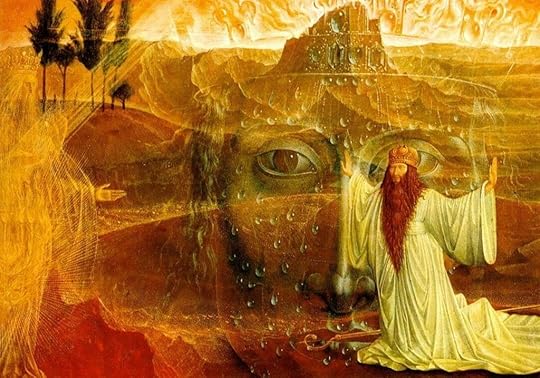 Moses & the Burning Bush, Ernest Fuchs, 1957
Moses & the Burning Bush, Ernest Fuchs, 1957Nevertheless, experience of the Divine is an individual thing; each one of us must experience Isis for ourselves. Groups and teachers can help. Clergy can facilitate. Books can point out a path. Talking with others and listening to what they say about their experiences can strengthen us in our desire for our own experience of the Goddess. But, in the end, we will not truly know the is-ness of Isis for ourselves until we have our own experience of Her.
We got used to using those words, faith and belief, when speaking about religion. But perhaps those are not the right words.

For me, what proves that Isis is real is my experience of Her, not my faith or belief in Her. No single book is the touchstone for my spirituality, though I find spiritual truths in many, many books written by many, many wise human beings. I can’t transfer my deep knowing of Her reality to anyone else (though I admit that the exercises and rituals I share with others are attempts to at least set up the conditions that will enable others to discover their own experiences of Her).
When that experience comes for the first time, it may bring awe, tears, joy, pain. When it comes again and again, throughout the many years, I can tell you that it may still bring all those things. But repeated and ongoing experience of the Goddess will also bring a deep knowing, a personal gnosis, of Her. No longer operating just “on faith,” now we know Her reality because we have experienced it. No longer just believing, we have discovered Her truth for ourselves and it has become our truth—the truth that She IS.
 Yes, Goddess, O yes!
Yes, Goddess, O yes! This stunning sculpture is by artist Paige Bradley. It is called Expansion. Here’s an article about this incredible piece of art.
February 26, 2023
Dreams, Healing & Isis
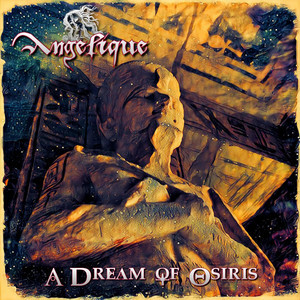 A Dream of Osiris
A Dream of OsirisI wonder if Osiris dreamed while He was dead? Did He dream of Isis? Did He dream of being healed?
Sometimes, people write to me about their Isis dreams. They hope for confirmation of the importance of the dream. (That’s usually easy. If it hits you hard enough to seek an outside opinion, then yes, it is an important dream.) More often, they want to know whether their dream was, in fact, a dream of Isis or a dream from Isis. (That’s usually a bit harder to tell without knowing a lot more about the person.) Perhaps you have your own Isis dreams? I know I do. One of the most important was the dream I had when She finally accepted me as Her priestess and it filled me with bright, turquoise-colored joy.
 More wonderful art from Andrew Gonzales
More wonderful art from Andrew GonzalesIsis is, most certainly, a Goddess associated with dreams and dreaming. Anciently, people slept in Her temples in order to receive dreams. They sought out dream interpreters to help them decipher the meaning of dreams they believed She had sent them. They fulfilled commands that She asked of them in their dreams. And often, what they sought from the Goddess were healing dreams.
We know that healing dreams were important throughout Egyptian history, even though much of our more concrete evidence comes from the later Greco-Roman period. For instance, the Greek historian, Diodorus of Sicily, writing in the 1st century CE, tells us that Isis
gives assistance in their sleep to those seeking it, visibly revealing Her very own presence and Her beneficence towards those in need. As proof of these claims they say that they themselves offer not myths akin to those of the Greeks, but visible results: for nearly all of the inhabited world serves as witness for them, seeking to add to Her honors because of Her manifestation through healings. For appearing in their sleep She gives aid to the sick against their diseases, and those who heed her regain their health contrary to all expectation. (Capitalization mine.)
Diodorus Siculus, Library of History, I.25
Diodorus also notes that Horus, through the teaching of His mother Isis, is also an oracle and a healer.
The practice of ritual sleep in a temple of healing Deities like Isis, Hathor, Serapis, and Asclepius is known as incubation. It’s a modern term for this ancient practice. It comes from the Greek term enkoimesis, induced sleep, and Latin incubatio, meaning “to lie down” (like a hen on her eggs). We know of a Greek orator named Aristides who made quite a practice of temple sleep throughout the Mediterranean world; some scholars think he may have been something of a hypochondriac. But happily for us, he wrote about his travels in search of healing. In one account, he writes of making a sacrifice of geese to Isis prior to receiving health information in dream from Serapis and Asclepius “pertaining to my salvation.”
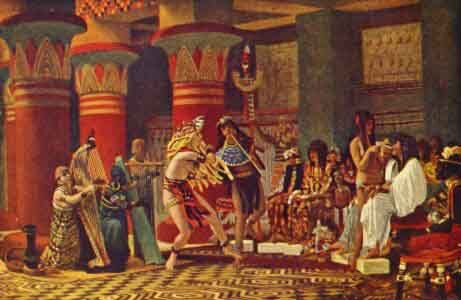 An artist fantasy of an Egyptian incubation temple
An artist fantasy of an Egyptian incubation templeA fragment from the Roman writer Varro mentions a healing dream in which Serapis “comes in my sleep, and orders me to eat onion and mint,” which gives us an idea of the types of dream prescriptions these Deities might provide. We also have a letter from a Greek hetaira named Aspasia who sought healing through dream in the temple of Isis at Memphis. Isis temples at Canopus and Menouthis were also famous for dream healing. At Menouthis, Isis was known as Isis the Physician. Priests (and probably priestesses) working in the temples might have divine dreams as well. We have records of a priest named Hor who was very much involved with both dreaming and Isis. Read his story here.
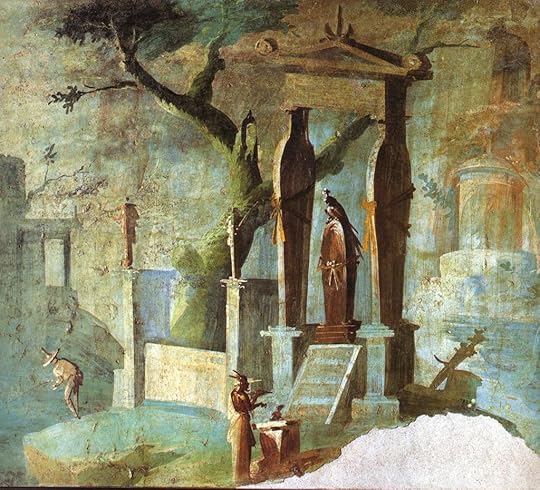 A dreamy landscape from the Temple of Isis in Pompeii
A dreamy landscape from the Temple of Isis in PompeiiOf course, not everyone could afford travel to a temple for their healing dreams. There were, no doubt, personal dream rites that one could undertake at home. Some of these may be preserved in the Greco-Egyptian Magical Papyri (aka PGM). There are numerous spells for receiving dream oracles. One interesting one involves the God Bes (Besas in the spell) in which the dreamer is to use strips of “the black cloth of Isis” as a protective device, preserving a magical drawing on the hand and around one’s neck during sleep.
One of the risks of dreaming at home—whether as divination or just the normal consequence of sleep—was nightmares. Here, too, one might call upon Isis for healing from the shock or fear of nightmare. As is often the case, here the dreamer takes the part of Horus, child of Isis, with Isis as His motherly comforter:
Words spoken by a man who wakes up on his place: “Come to me! Come to me my mother Isis! Behold, I see something far away from me, as something that touches me.”
[The Goddess replies]: “Here I am, my son Horus. Do not divulge that which you saw, that your numbness may be completed, your dreams retire, and fire goes forth against that which frightens you. Behold, I have come that I may see you, that I may drive out your bad things, that I may eliminate all the ailments.”
[The dreamer speaks]: “Hail, O you good dream, which is seen in the night and in the day. Drive out all the ailments and bad things which Seth, son of Nut, created. As Ra is vindicated against his enemies, I am vindicated against my enemies.”
This spell is to be spoken by a man who wakes up on his place, after he has first been given pesen bread and some fresh herbs (which have been) marinated in beer and incense. The man’s face should be rubbed with them; all the bad dreams that he has seen will be driven out.
Chester Beatty Papyrus III
The dream world is an odd and interesting place. Sometimes, it’s purely our own “stuff;” re-hashing of the day’s events, the last thing we read or movie we watched, stress or frustrations that manifest as monsters or irritating “I can’t find my purse” dreams. (Ugh. I hate those.) But sometimes important things come to us in dream. And those dreams have a different “flavor.” They stand out. They may be more vivid, detailed, or just plain weird. They may represent a bubble from our own unconscious that we really, really should pay attention to. Or they may be a connection with something, someone, or Someone Who is [also] outside our own psyche. Like Isis, perhaps. Or our own Higher Self tapping out a “wake up” tune on our sleeping Isis Hearts.
 A world between life and death
A world between life and deathFor the ancient Egyptians, the dream state enabled the dreamer to enter another world, somewhere between life and death. In the funerary literature, death of often compared to sleep with the deceased being enjoined to awaken. Perhaps that is why the most common Egyptian term for dream was rsw.t, from a root meaning “to awaken.” So in dream, we awaken in our sleep; to be preferred to the unconsciousness of dreamless sleep or death.
I think there’s more to this discussion of dreams and Isis, but that’s enough for now.
What do you think? Does Isis communicate with you in dreams? Do you dream of Her? Do your dreams ever help you in healing?
February 19, 2023
Red Isis
 Oregon’s Painted Hills
Oregon’s Painted HillsEgypt has its Red Land, its desert, but so does my home state of Oregon. My Red Land is in eastern Oregon, just over the mountains from Portland.
The eastern Oregon desert is starkly impressive dressed in its iron-rust reds, dry-grass golds, basalt blacks, and pale, dusty sagebrush and juniper greens. And the Painted Hills! O my Goddess, beautiful, beautiful.
In honor of these red harmonies, I’d like to dive into the color red, its symbolism in ancient Egypt, and its relationship with Isis, Who—as we have seen—can be a fiery Goddess Herself.
In truth, the ancient Egyptians had an interesting relationship with the color red, in Egyptian, desher. It was considered very powerful—in both a bad way and in a good way. The bad way connected red with danger, anger, and of course, the non-life-sustaining desert or desheret. (As you can see, our word for “desert” comes from ancient Egyptian desheret.)
 A modern rendition of the fiery Set
A modern rendition of the fiery SetRed was associated with the red-haired and red-eyed God Set, a God Who can be angry, powerful, and destructive—as well as helpful and protective. In the Greco-Egyptian magical papyri (aka PGM), you will sometimes see instructions that tell the magician to obtain a lamp “not colored red,” no doubt so as to not taint the magic with the negative aspects of the color red. The Egyptians described someone who was raging or furious as “red of heart.” Red ink would be used to write the names of dangerous creatures or Divinities in the temple scrolls. In the calendars that show lucky and unlucky days, the unlucky days were written in red ink, while the lucky ones were written in black.
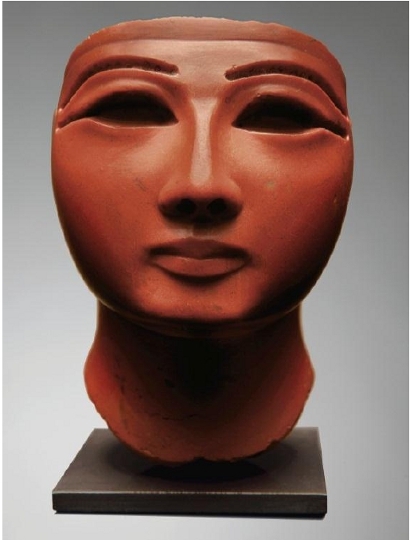 A pharaoh’s head in red jasper
A pharaoh’s head in red jasperOn the other side of the ledger, red could also be associated with life, warmth, and protection, while still maintaining its ambiguous nature. Life-giving blood is red and connected with birth, rebirth, and regeneration, but it can also mean death if we lose too much of it. Warming and light-giving fire is red, but can be dangerous if uncontrolled. Red is the color of the radiant Sun God Re, but it was also the color of the Eye of Re, the Serpent Goddess Who could be either destructive or protective.
When it comes to Isis, we usually find red in its positive aspects. (Though it is true that the myths show that Isis can get a bit “red of heart” when it comes to protecting Horus’ interests.) Nevertheless, Isis is most often associated with red’s favorable characteristics: the promotion of life, protection, and regeneration.
Her famous amulet, the Knot of Isis or tiet, was usually made of red stone such as red jasper or red carnelian. In what I suspect is a modern legend—yet quite appropriate to the mythology of Isis—it is said that Isis wept tears of blood over the death of Osiris and these crystallized as carnelian. From them, the Goddess carved Her red tiet amulet.
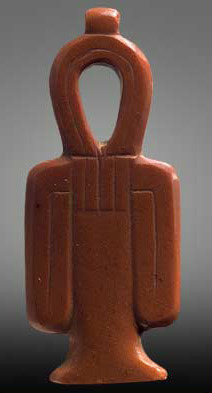 A classic red Knot of Isis
A classic red Knot of IsisThe tiet first appears in Egyptian iconography in the third dynasty. It was frequently used in association with the djed pillar of Osiris and so eventually became almost exclusively associated with Isis. Used together, the two symbols could refer to the power of the Goddess and God to engender Life. Because of this, the symbols may also be seen as sexual symbols; the pillar referring to the phallus of the God and the knot to the vulva and womb of the Goddess.
Once born, the new or renewed life would have to be protected, the perfect job for a magical knot. In fact, the formula to be spoken over an Isis Knot of red jasper connects the red of the amulet with the blood, power, and magic of the Goddess and is intended to protect the deceased during her or his transformation after death:
You have Your blood, O Isis. You have Your power, O Isis. You have Your magic, O Isis. This amulet is a protection for this Great One and which will drive away whoever would commit a crime against him.
Formula 156, Book of the Dead
You may recall that this amulet is also called the Blood of Isis and may represent the red lifeblood of birth or even red menstrual blood. Some say the amulet is shaped like the cloth worn by ancient Egyptian women during menstruation. Others have interpreted it as a representation of a ritual tampon that could be inserted in the vagina to prevent miscarriage. In this case, it would have been the amulet Isis used to protect Horus while He was still within Her womb.
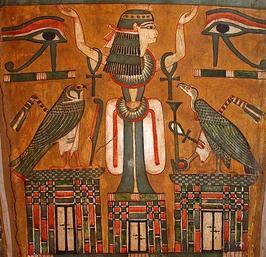 The Knot of Isis personified as a Goddess, giving life
The Knot of Isis personified as a Goddess, giving lifeIn addition to Her red amulet, Isis is one of the Goddesses Who is the protective and powerful Eye of Re and we have already seen how Isis is associated with the redness of fire as well as the redness of a fierce nature. In a text from the Temple of the Birth of Isis at Hathor’s temple complex at Denderah, Isis unites the power, magic, and life-renewing qualities of the colors red and black in Herself for it is said that She was born “in the form of a black and ruddy woman, endowed with life, sweet of love.”
Red is the color of Isis’ distinctive, protective amulet. Red is the color of Her life-giving blood. Red is the color of Her powerful magic. Red is the color of the warmth, strength, and illumination of Her fire. Red is the color of the powerful, magical, fiery, life-giving Goddess Herself: Red Isis.
February 12, 2023
I am Isis—the Goddess & Her Aretalogies
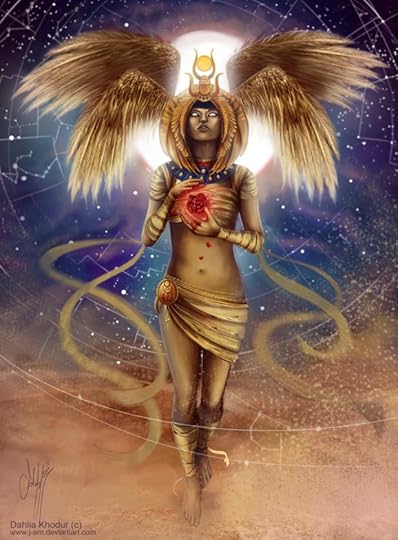 I very much like this Cosmic Isis by artist Dahlia Khodur. Here’s a link to her Instagram, though I don’t see this one there.
I very much like this Cosmic Isis by artist Dahlia Khodur. Here’s a link to her Instagram, though I don’t see this one there.Let’s talk a bit about the Isis aretalogies.
The aretalogies are those first-person statements in which the Goddess details Her many accomplishments and gifts to humankind. Here’s an except from one in case you need a little reminder:
I am She that riseth in the Dog Star.
I am She that is called Goddess by women.
For me was the city of Bubastis built.
I divided the earth from the heaven.
I showed the paths of the stars.
I ordered the course of the sun and the moon.
I devised business in the sea.
I made strong the right.
I brought together woman and man.
I appointed to women to bring their infants to birth in the tenth month.
I ordained that parents should be loved by children.
I laid punishment on those disposed without natural affection toward their parents.
I made with My brother Osiris an end to the eating of men.
I revealed mysteries unto men.
The word “aretalogy” is, as you may be able to tell, Greek. Arete means “virtues” and logy is from logos, “word,” so aretalogy is “speaking about virtues.” In aretalogy, the Deity is usually speaking in the first person about Her or His own virtues. But that’s not always so. For instance, the Aretalogy of Maronea is not spoken by the Goddess Herself, but by someone whom She healed. In Her honor, he speaks of Her virtues.
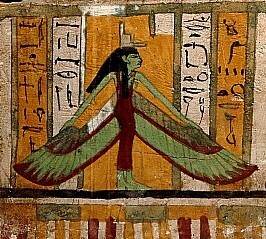 I am Isis. I revealed Mysteries unto humankind.
I am Isis. I revealed Mysteries unto humankind.Isis is one of the few Deities for Whom we have quite a number of aretalogies. As with many Things Scholarly, there are disagreements about which of these documents should be considered aretalogies, so there’s no canonical count. But we can think in terms of six to ten. (That does not count the many, many hymns to the Goddess.)
The existing copies of these important documents are all written in Greek and date (we think) from the 2nd century BCE to the 2nd or 3rd century CE. Some of the scholars who have studied them have looked for ancient Egyptian precedents for the ideas in them, others believe them to be purely Greek in origin. Dieter Muller, a German Egyptologist who studied the texts extensively, took 56 phrases that refer to Isis in the aretalogies and tried to trace them to their sources. He concluded that nine were, in both form and content, Egyptian in origin, seven were Egyptian but expressed in a Greek way, 24 were of Greek origin, and 16 uncertain, but possibly Greek.
Another scholar, Jan Bergman, traced each of the statements to an original Egyptian concept claiming that the statements cannot be properly understood unless placed in context with Memphite religion and the relationship between the Egyptian Deities and Egyptian royalty. Louis Zabkar, an Italian-born Egyptologist who studied the hymns to Isis at Her Philae temple, believes that the Philae hymns contributed to the content of the aretalogies. In a epilog to his book about Isis’ Philae hymns, Zabkar takes another look at Muller’s work and expands the number of Egyptian-original aretalogical statements to 23, making them almost equal to the number of Greek-original statements. More recent scholars, too, have traced more and more of the self-statements to Egyptian originals.
 One of two female figures at the entrance to the Egyptian Museum in Cairo; given that the museum opened in 1902, she is probably supposed to be either Cleopatra or Isis
One of two female figures at the entrance to the Egyptian Museum in Cairo; given that the museum opened in 1902, she is probably supposed to be either Cleopatra or IsisTwo of the aretalogies (from Kyme & Andros) state that they were copied from a stele “before the temple of Hephaestus [that is, Ptah] at Memphis.” Scholars thus sometimes refer to this as the M-text and believe that it could be the original from which all the other aretalogies were either copied or developed.
Some researchers have suggested that the thoughts of a famous Greek atheist contributed to the content of the Isis aretalogies. His name was Prodicus and he was a Greek philosopher (5th century BCE). His idea was that the gods were not divine at all, but were instead brilliant human beings from a primordial time who were so beneficial to humankind that people deified them. We usually hear of this idea tied to the name of a Greek mythographer named Euhemerus (4th century BCE). In fact, we even give it his name: euhemerism. But Euhemerus most likely got the idea from Prodicus.
Euhemerism was one of the ways the ancient Pagan Deities survived in the Christianized West. Since They (or they) were merely human beings, their myths could be retold—and even be used to teach “Christian” virtues. This definitely happened with Isis. (Isis Magic details some of the ways the story of Isis remained a part of the culture during this time.)
 An elegant Isis from the 25th dynasty
An elegant Isis from the 25th dynastyBut what does all that have to do with the aretalogies? Some scholars (Fritz Graf; Albert Henrichs) suggest that this type of Prodican euhemerism—especially in relation to the cultural gifts of the Deities—was going on in the Eleusinian cults at that time. And, since Isis and Demeter were being equated, the Eleusinian euhemerism was applied to Isis and shows up in the Isis aretalogies. You can see it strongly in the Maronea aretalogy, which may be the oldest of these Isiac documents that we have. (It does not, however, explain the “I-am” structure of the Kyme aretalogy, which is very unlike a Greek hymn and much more similar to the starker statements of Egyptian hymns.)
Now, it’s not that the Eleusinians who took up some of Prodicus’ ideas were atheists themselves. We could say that they were merely adopting one of the memes of their day. They liked the idea of their Deity being the source of important aspects of culture and incorporated it.
Some scholars believe the Isis aretalogies were created as propaganda to help spread the gospel of Isis throughout the Mediterranean. At least to some extent, that’s probably so. But there are other ideas, too. I’m reading an article right now that argues they were read aloud as part of initiation into the Mysteries of Isis. To me, the argument isn’t persuasive due to the strict secrecy of the Mysteries. If the aretalogy was recited as part of the key epiphany of the Goddess in Her Mysteries, it would likely have been kept secret rather than carved in stone and set up before the temple of Ptah in Memphis. But it’s a very intriguing idea nonetheless.
Interestingly, we have a dedication from the island of Delos made to Isis and Anubis by an “aretalogos.” If there was a regular priestly function as a Speaker of Aretalogies, perhaps the recitation of an aretalogy was part of the standard worship of the Goddess rather than part of Her Mysteries. Another suggestion is that they were read during Her great feasts.
 A priestess making offering; photo by Victor Keppler
A priestess making offering; photo by Victor KepplerWhether PR or liturgy, it seems most likely that both Egyptian and Greek elements formed the conceptual basis of the Isis aretalogies. Memphis was one of the places where Egyptian and Greek ideas came together, and apparently without rancor. Here, key religious ideas of both Egyptians and Greeks blended, and could have resulted in the M-text.
But I wonder whether personal elements could have figured into the creation of the aretalogies as well. At least some of you have had Her speak to you in this way, telling you of Her arete in first person. It is a powerful experience; not likely to be forgotten. Perhaps you’ve even written it down to commemorate it.
For, as She has always done, Isis can speak directly to our hearts, telling us Who She Is, and especially Who She Is for us right now.
February 5, 2023
An Isiopolis tale
 A reconstruction of the Isis temple complex at Isiopolis
A reconstruction of the Isis temple complex at IsiopolisAs you might know if you read the “Isiopolis” tab of this blog, Isiopolis is the Greek name of the ancient Egyptian city in which the greatest Lower Egyptian temple of the Goddess Isis once stood. It means simply, City of Isis. Ancient Roman visitors called the temple there the Iseum (from Greek, Iseion), meaning the Sanctuary of Isis. Pliny, in his book Naturalis Historia, also took note of the Egyptian Delta’s City of Isis—in Latin, Isidis Oppidum.
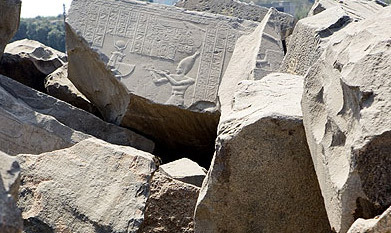 The finely-carved ruins of Isiopolis
The finely-carved ruins of IsiopolisThe modern Egyptian town is Behbeit el-Hagar in Arabic and comes from the ancient Egyptian Per-Hebitet, meaning the House (per means “house” or “temple”) of the Festive Goddess, an epithet of Isis. In Egyptian, the hebit part of the name may refer to a special festival pavilion used during the Isiac rites there. In Arabic, “Per-Hebitet” became Behbeit and “el-Hagar” means “of the stone blocks,” which makes sense given the state of the site. A papyrus from the Third Intermediate Period also calls Isiopolis “the place where offerings are set down.”
If you’d like to learn more about the site itself, read more here.
For today, I’d like to tell you a legend about Isis and a temple neighboring Isiopolis that I recently came across and which I hadn’t heard before.
We only have part of it, but here’s what we have:
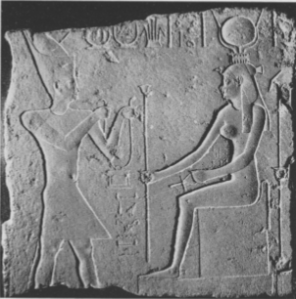 Ptolemy offering to Isis; from the Temple at Isiopolis
Ptolemy offering to Isis; from the Temple at IsiopolisPharaoh Nektanebos, a king of the 30th dynasty and a devotee of Isis, came to Memphis to make sacrifice to the Deities there and to ask Them to reveal to him the future. He performed the proper rites, then went to sleep and dreamed. In his dream, he saw Isis enthroned in Her sacred boat and surrounded by all the Deities. Presently, the God Onuris (Anhur) came before Isis and complained that Nektanebos—of whom Onuris had taken particular care, by the way—was neglecting the completion of His temple at Sebennytos. (In Sebennytos, Onuris was a warrior God and assimilated with Shu. He was said to have been the one Who brought back the raging Lioness Goddess, that is, His consort Mehyt, Who we learned about here.
Upon waking, the pharaoh immediately sent for the priest of Onuris to ask how the work was going. Apparently, everything was done except the hieroglyphs. So they sent for the famous carver, Petesis (whose name means “given by Isis”). Well supplied with money, Petesis set off for Sebennytos. But Petesis well-liked both women and wine, so he stopped off in town before heading to work. As good storytelling would have it, he met a beautiful apothecary’s daughter and…
That’s where the text breaks off. Argh. So many hints like this remain to us, but so often we lack the whole picture. Onuris’ temple wasn’t completed until 60 years later, so apparently Petesis never did finish his work.
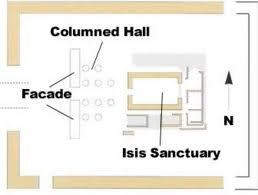 The main Isis temple at Isiopolis
The main Isis temple at IsiopolisJust north of Onuris’ temple lay the great temple of Isis at Isiopolis (I know, that’s the Greek name, but I just love the word; say it a few times and you might, too). Judging by the remains, the temple was built entirely of granite, which was rather unusual. Most of it was made of black granite, with some blocks of fine, red granite. The carvings are particularly beautiful, yet today, the entire site is in complete ruins…just a bunch of “stone blocks” littering the area. One of the blocks from this important Isis site has been found in Rome, apparently taken there to become part of the main Roman Isis temple.
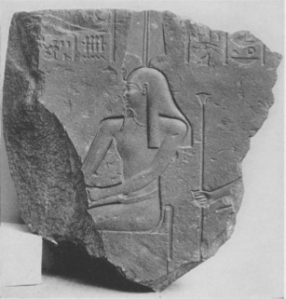 Osiris of Isiopolis, looking pretty spry
Osiris of Isiopolis, looking pretty spryIsis was known as the Lady of Hebitet and Osiris as the Lord of Hebitet. But at Isiopolis, Osiris was not shown as the mummiform God. Rather, He was depicted as the renewed king, wearing the atef crown. Surely this is the magic Isis worked at Her temple in Isiopolis: nothing less than the renewal of Osiris. The roof of the temple seems to have had a number of shrines to various aspects of Osiris and would seem to have been a logical place for the festival pavilion of Isis mentioned earlier. Embalming often took place in special tents or pavilions and temple roofs often served in rites of renewal. Perhaps at Isiopolis they performed a combined rite of death and renewal that left Osiris young by virtue of Isis’ powerful magic and protected beneath Her beautiful wings.
January 29, 2023
Early Feminist Margaret Fuller & Isis
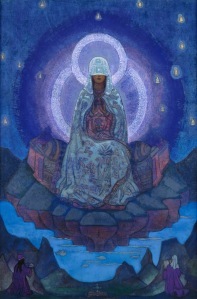 This painting is by Nicholas Roerich and is called Mother of the World. I first encountered it as the cover art of Caitlyn Matthew’s book on Sophia. Beautiful and powerful, as Goddess is.
This painting is by Nicholas Roerich and is called Mother of the World. I first encountered it as the cover art of Caitlyn Matthew’s book on Sophia. Beautiful and powerful, as Goddess is.Almost from the moment I began to think about my own spirituality, I intuited that I needed the Divine Feminine, the Goddess—a Deity in Whose image I, a woman, could be considered to have been created.
I joyfully credit feminism with offering not only me, but our society as a whole, the freedom to consider that Deity not only could be feminine, but had been for a very long time. Like maybe forever. With this freedom, in time, I found what my soul and spirit needed in Isis.
Indeed, I have always considered Isis’ myth to be a pretty strongly feminist tale, especially for its day. I’ve written about that here.
As it turns out, Isis has been inspiring feminists for quite a long time. Only recently I discovered that Margaret Fuller, a journalist and prominent early women’s rights advocate, also had a thing for Isis. More on that in a moment. First, more on Margaret.
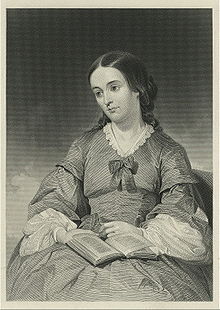 An illustration of Margaret Fuller
An illustration of Margaret FullerBorn in 1810, Margaret Fuller was the first female editor of the New York Tribune and its first female foreign correspondent. She advocated for the rights of women, the emancipation of slaves, and prison reform. She earned such a reputation for scholarship that she was the first woman Harvard allowed to use its library. Her book, Woman in the Nineteenth Century, published in 1845, is considered the first feminist work in America and the first major work since the English writer Mary Wollstonecraft’s Vindication of the Rights of Women in 1792. In addition to equality before the law and in marriage, Fuller argues in her book for woman’s need to gain intellectual and religious freedom, which she believed would in turn promote enlightenment for both sexes.
Her book began life as an essay published in The Dial, a transcendentalist paper that Fuller edited. Transcendentalism was a religious and philosophical movement of the time. Central beliefs included the goodness of the individual and nature, the unity (as opposed to trinity) of the Divine, and the rejection of much of the organized religion of its day as subject to corruption. Henry David Thoreau and Ralph Waldo Emerson are two names closely tied to transcendentalism. Transcendentalism was inspired by a variety of religions and religious writing, including the Hindu Vedas, Upanishads, the Bhagavad Gita, and the work of Emmanuel Swedenborg.
Yes. We’re getting to Isis. I mention transcendentalism to give you an idea of Fuller’s religious explorations and to introduce you to Emerson, who played an important part in Fuller’s life with Isis.
Fuller was first exposed to Isis when she read Ovid’s Metamorphoses as a child. She fell in love with the story of Iphis & Ianthe in which Isis is a prominent figure. Don’t know that story? Read all about Isis, Iphis & Ianthe here.
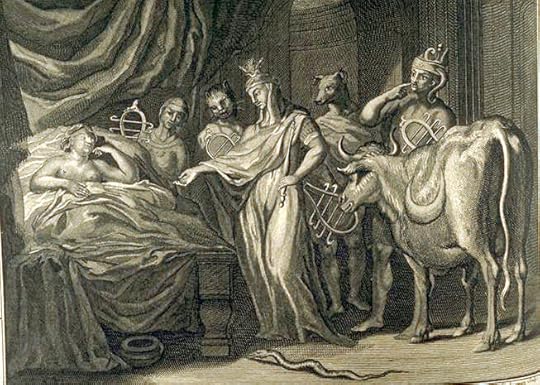 Isis and entourage visit Iphis’ mother in Ovid’s tale of Iphis & Ianthe
Isis and entourage visit Iphis’ mother in Ovid’s tale of Iphis & IantheMuch later, Isis played a role in helping Fuller define her ideas about feminine Divinity in the face of the all-masculine images of God so prevalent in her (and our) society; this according to Jeffrey Steele, who has studied Fuller’s work extensively. We have one of Emerson’s letters in which he notes that Fuller adopted the Isiac sistrum as a personal symbol—clearly pointing to how important the Goddess was to her. From their letters, we know that Emerson and Fuller discussed Plutarch’s essay “On Isis & Osiris” and that, to some extent, Emerson identified with Osiris and Fuller with Isis. It is clear that Fuller was seeking Goddess from an entry in her 1839 journal: “I have never been so near the fountain of inspiration, yet I have not attained to drink. The divinity flits before me, a glittering phantom on the mead, her eyes divine look up to me from the depths of still waters, yet I can never lay hold of her robe or dive to the depth of her grotto.”
In a short story Fuller wrote, “A Tale of Mizraim,” Zilpah, a Hebrew slave, is in love with the Egyptian prince, Amaris. He tries to persuade her to stay with him and that Isis, Whose worship is love, is superior to Jehovah. Yet Zilpah must go with her people who are just about to leave Egypt on the heels of all those biblical plagues. Then Zilpah has a dream-vision of Isis:
“By her side sat a fair being, a woman of majestic mien, arch brow; but the soft, pale sadness of her lips, forbade awe in her presence, and turned the heart to tender reverence. Her forehead was surmounted by a glittering crescent, and when her blue eyes were fixed upon the waters, a long line of silvery light appeared. After a while, she turned on Zilpah a smile so bewitchingly sweet, that the maiden sank at her feet…”
 A highly romanticized painting of the pharaoh’s daughter finding Moses by Edwin Long, 1886.
A highly romanticized painting of the pharaoh’s daughter finding Moses by Edwin Long, 1886.Then the vision changes and Zilpah sees Amaris drowning. As she desperately tries to rescue him, the vision ends. Ultimately, however, Zilpah chooses Jehovah, begging Moses to pray that Jehovah spare her child by Amaris from the coming plague of the first borns. There is no mercy from Jehovah for Zilpah. Their child dies. In mourning, Zilpah leaves with her people only to see her beloved Amaris die as the Red Sea closes over him. At that shock, Zilpah herself expires. Even though the story seems to endorse the choice of Jehovah, modern readers are left to wonder whether Zilpah wouldn’t have been happier remaining in the land of Isis.
As part of her work toward the intellectual freedom of women, Fuller held a series of Conversations, which were intended to provide information about topics to which women of her day were not often exposed. Among these were what might be learned from all that old Pagan mythology. Fuller seems to have recognized the overarching theme of the Great Goddess, a Feminine Deity found in myths all over the world. She was particularly struck by the myths of the searching Goddesses—Isis and Demeter most prominent among Them, of course. At a certain period in her life, Fuller felt herself to be wandering as she tried to come to terms with her own need of Goddess, an option that simply was not available to her at that particular time and place.
Interestingly, in an appendix to her important Woman in the Nineteenth Century, Fuller included a translation of Apuleius’ famous tale of initiation into the Mysteries of Isis. Even earlier, she had written a poem clearly inspired by that story. Here’s an excerpt:
So in Egyptian clime
Grows an Isis calm sublime
Blue black is her robe of night
But blazoned o’er with points of light
The horns that Io’s brow deform
With Isis take a crescent form
And as a holy moon inform.
The magic sistrum arms her hand
And at her deep eye’s command
Brutes are raised to thinking men
Soul growing to her soul filled ken.
Margaret Fuller
There is much more to this complicated woman than I can even summarize here. She had tempestuous relationships with women and men. She argued with Emerson. She went through spiritual crises. She traveled to Rome to write a history of the Republic. She fell in love and married an Italian nobleman. She died too early, shipwrecked on her way back to America, her manuscript on Rome lost. I am sure she must have seen much of Isis in Italy that connected with her love of Apuleius’ tale of the Goddess.
I wonder what she would have thought of those of us today, people of all genders alike, who love Isis as she seems to have done, but who now have more freedom to express that devotion.

January 22, 2023
Isis & D.H. Lawrence
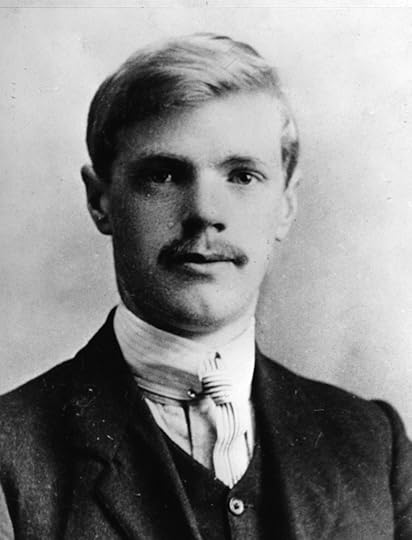 D.H. Lawrence as a young man
D.H. Lawrence as a young manIf you’ve read Ronald Hutton’s masterful Triumph of the Moon, a History of Modern Pagan Witchcraft, you might remember a chapter in which Hutton refers to a novella by D. H. Lawrence in which The Man Who Died survives His crucifixion, meets a devout Priestess of Isis, honors her Goddess, and makes love with her as her Osiris.
Wait…what!?
D.H. Lawrence, author of Lady Chatterly’s Lover and other well-known erotica, wrote a story about Isis and Her priestess? Turns out, yep. He did. Is it erotic ala Lady Chatterly? Turns out, yep, it is. In fact, it gives a whole new meaning to the phrase, “He is risen!”
I am not kidding.
It must have caused more than one vicar’s head to explode when it first came out in 1929, a year before Lawrence’s death. This novella was his last work.
Here is Lawrence’s own summary of the story in a letter to a friend:
I wrote a story of the Resurrection, where Jesus gets up and feels very sick ’bout everything, and can’t stand the old crowd any more—so cuts out—and as he heals up, be begins to find what an astonishing place the phenomenal world is, far more marvelous than any salvation or heaven—and thanks his stars he needn’t have a mission any more.
D.H. Lawrence in a letter to his friend, the American painter, writer, and scholar Earl Henry Brewster
But as you already know from the introduction to this post, dear Isiacs, that is just the beginning of the story. So I shall tell you the rest.
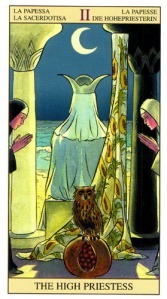 High Priestess at the sea
High Priestess at the seaFor the sake of completeness—and in the case that you might want to read the whole work for yourself—the title is The Man Who Died. That was the published title, but not Lawrence’s preferred one. His preferred title was The Escaped Cock. (And yes, the story actually does start with a cock. Jesus helps the rooster make his escape, just as Jesus is making His own escape from His fate.)
 Terracotta statuette of a priestess of Isis, Egypt, 2nd century CE
Terracotta statuette of a priestess of Isis, Egypt, 2nd century CEAnyway, on with our tale…
After some post-crucifixion healing up at the home of some peasants, Jesus has an encounter with the Magdelene (whom Lawrence calls Madeleine) that sorely disappoints her since Jesus refuses to return to the disciples with her. Instead, He leaves town, wandering until He comes to the sea at Lebanon.
At the sea’s edge, He comes upon a small Temple of Isis, built to face towards Egypt. It had been built by a 27-year-old priestess of Isis, who had tended it for the past seven years. She serves “Isis Bereaved, Isis of the Search.”
He describes the Goddess’ image like this:
The goddess, in painted marble, lifted her face and strode, one thigh forward, through the frail fluting of her robe, in the anguish of bereavement and of search. She was looking for the fragments of the dead Osiris, dead and scattered asunder, dead, torn apart, and thrown in fragments over the wide world. And she must find his hands and his feet, his heart, his thighs, his head, his belly, she must gather him together and fold her arms round the re-assembled body till it became warm again, and roused to life, and could embrace her, and could fecundate her womb. And the strange rapture and anguish of search went on through the years, as she lifted her throat and her hollowed eyes looked inward, in the tormented ecstasy of seeking, and the delicate navel of her bud-like belly showed through the frail, girdled robe with the eternal asking, asking, of her search.
D.H. Lawrence, The Man Who Died
This description doesn’t match any of the standard images of Isis, except possibly one of the Isis Pelagia images. The movement of the Goddess and Her garments that Lawrence describes can be seen in some of those images.
The priestess, the “flower of whose womb was cool,” has quietly been serving her Goddess, waiting.
Jesus and the priestess meet. He asks for shelter saying, “The Goddess is great.” The priestess gives Him shelter. The slaves of the priestess spot the marks on His hands and feet and declare Him a “malefactor.” Days pass as the two come to know each other. Jesus is numb to the world and has no interest in women. The priestess, too, she of the cool womb, has no interest in men.
But, of course, things change.
One day, the priestess invites Jesus to the temple with her to see the sacred image of the Goddess. He goes.
He followed her into the inner shrine, into the almost-darkness. When his eyes got used to the faint glow of the lamp, he saw the goddess striding like a ship, eager in the swirl of her gown, and he made his obeisance.
“Great is Isis!” he said. “In her search she is greater than death. Wonderful is such walking in a woman, wonderful the goal. All men praise thee, Isis, thou greater than the mother unto man.”
The woman of Isis heard, and threw incense on the brazier. Then she looked at the man.
“Is it well with thee here?” she asked him. “Has Isis brought thee home to herself?”
He looked at the priestess in wonder and trouble. “I know not,” he said.
The Man Who Died
[Ah ha! Lawrence must have been looking at an Isis Pelagia image. He even describes Her as striding like a ship.]
Oh yes; and it is important to know that Jesus could not be touched during all this time; His experiences made it just too much for Him. But things continue to change. The priestess comes to believe that Jesus is Osiris reborn. Jesus eventually does allow Himself to be touched by her. Jesus and the priestess of Isis make love in the temple before the sacred image of the striding Goddess. Touched by the priestess and the Goddess Herself, Jesus is healed just as Osiris is healed. He never asks the priestess’ name; she never asks His, for she already knows Him to be Osiris.
 I kinda love this piece of art
I kinda love this piece of art Time passes again and the priestess conceives a child.
But just as Osiris leaves Isis in His death, so Jesus must leave the pregnant priestess. Slaves have recognized Him and the Roman authorities are on the way. Jesus makes His escape.
If you wish to read the whole story—and it is worth doing—you’ll find it here.
I was prepared to be disappointed by the tale itself, but in general, I wasn’t. The writing is moody, only gently steamy, though the sexism of the day is apparent.
According to Hutton, the story is fully of its day; a time when, in England at least, many people were trying to reconcile Christianity with their ideas about little-p paganism and finding much good in doing so. The equation of Jesus-Osiris was well known in alternative religion circles of the period. But, of course, it wasn’t a new equation even then. Syncretism has a very long history.
At any rate, this story is one more link in our modern Isiac tradition and I’m very pleased that Mr. Hutton helped me to discover it. I hope you will enjoy it, too.



